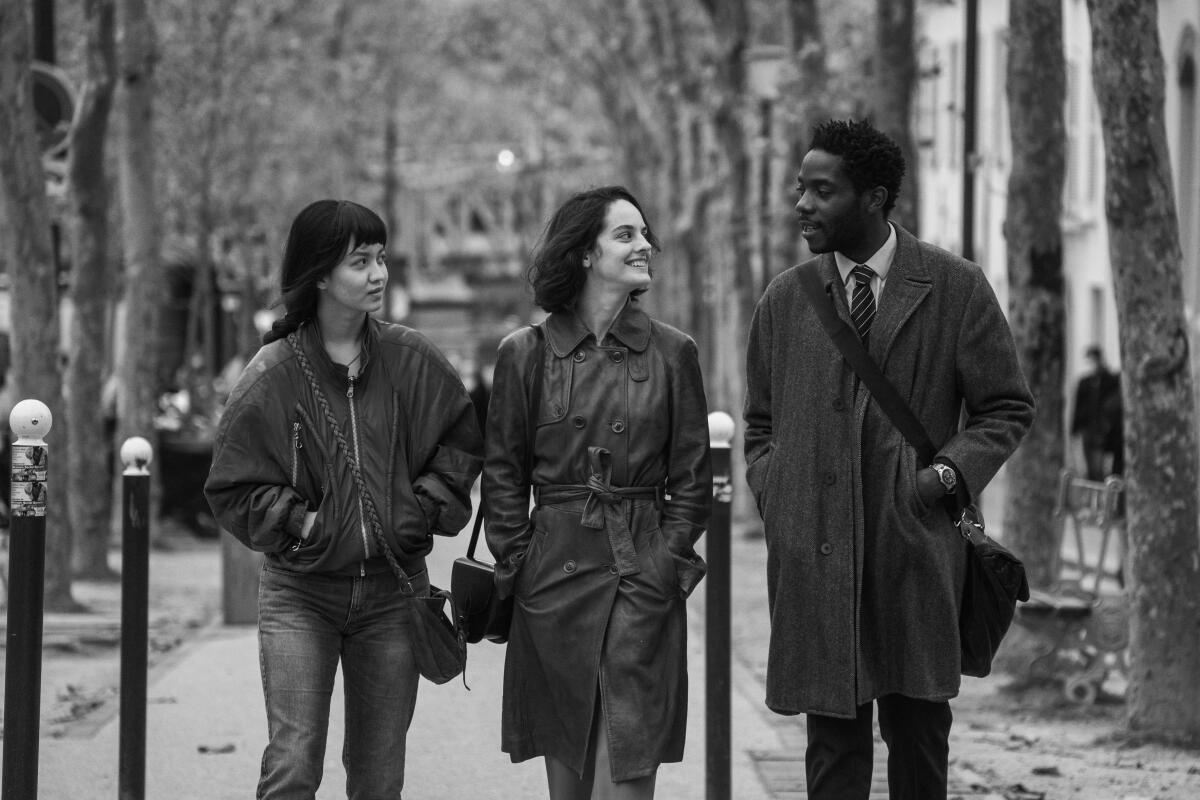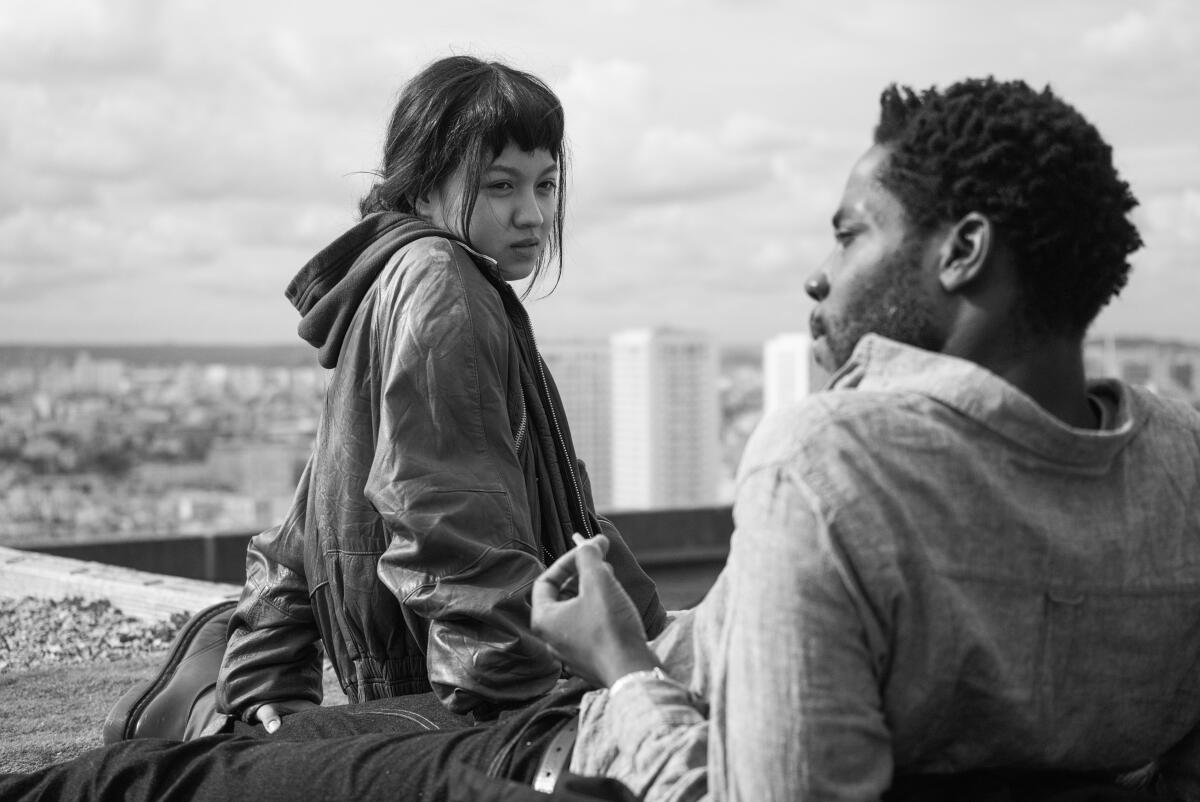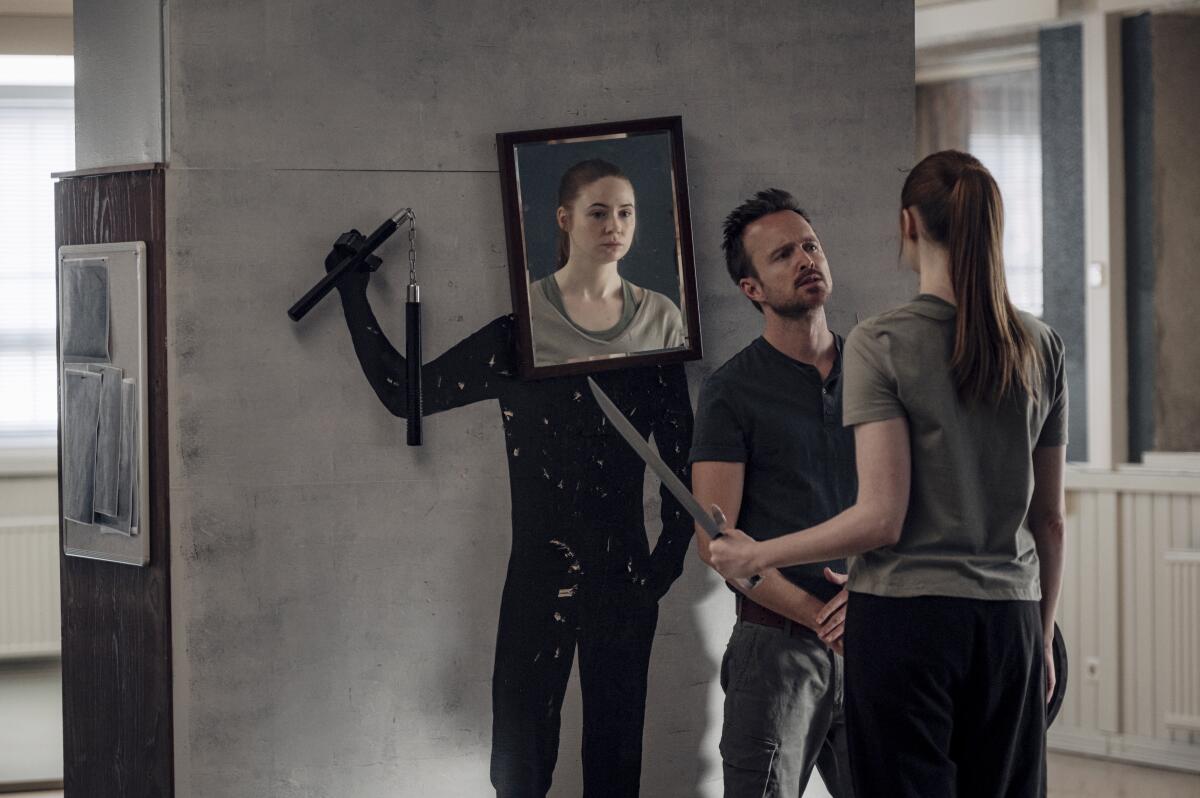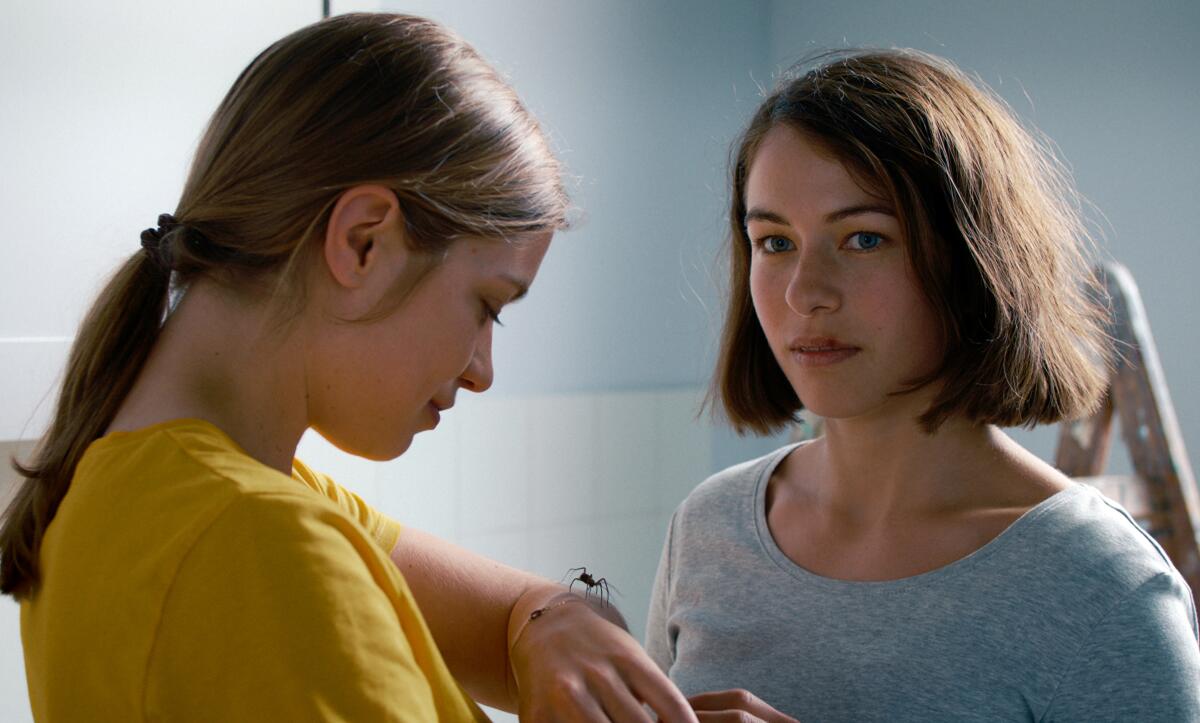Modern love is steamy and breezy in ‘Paris, 13th District’

- Share via
Hello! I’m Mark Olsen. Welcome to another edition of your regular field guide to a world of Only Good Movies.
Only good movies
Get the Indie Focus newsletter, Mark Olsen's weekly guide to the world of cinema.
You may occasionally receive promotional content from the Los Angeles Times.
“Everything Everywhere,” explained. A few weeks back, we spotlighted “Everything Everywhere All at Once,” and as the movie has expanded to theaters around the country, Jen Yamato checked in with filmmakers Daniel Kwan and Daniel Scheinert to better understand all that is mundane, profound and absurd in the movie, including family, hot dog fingers and a “Ratatouille”-like raccoon chef.
“When you stare at something for long enough, you can make anything meaningful,” said Kwan. “That’s a desperate, dangerous thing, but it’s also really beautiful. We need that right now because everyone is staring at everything and seeing no meaning at all. This movie’s almost us trying to fight that by saying, ‘Look, rocks can make you cry!’ There’s beauty and meaning in everything. It can be butt plug trophies. It can be family drama in a laundromat. We’re putting them all on the same plane. There is no lowbrow or highbrow. It all exists, and we have to be OK with that.”
Added Scheinert: “There’s lowbrow and highbrow, but all the brows are good.”
The TCM Film Fest returns. The TCM Classic Film Festival will run from April 21 to 24 in Hollywood, opening with a 40th anniversary screening of “E.T the Extra-Terrestrial” with Steven Spielberg, Drew Barrymore, Dee Wallace, Henry Thomas and Kathleen Kennedy among those scheduled to attend. Other highlights from the program include “Polyester,” “Drunken Master II,” the 1978 “Heaven Can Wait,” “Annie,” “The Last of Sheila,” “Giant,” “Return of the Secaucus Seven,” “Topkapi,” “Tootsie,” “All of Me,” “Cooley High,” the 1937 “A Star Is Born,” “Jewel Robbery,” “Cocktail Hour,” “Counsellor at Law” and many more.
Cary Fukunaga is on the ground in Ukraine. If, like me, you started following “No Time to Die” filmmaker Cary Joji Fukunaga on Instagram for behind-the-scenes glimpses of his filmmaking work, it has been startling and rather moving to see he has been in Ukraine since sometime in March, posting photos and videos of what he has been witnessing.
In an email to The Times’ Salma Loum, Fukunaga said, “I’ve taken pictures, but I’m here as a humanitarian and not a documentarian.”
The Festival of Books is almost here. The L.A. Times Festival of Books will run April 23 and 24 on the USC campus. I will be moderating a panel that Saturday titled “Showbiz Visionaries,” with authors Dana Stevens, Nick Davis, Isaac Butler and Kenneth Turan (also a former Times film critic).
The Times just published a comprehensive guide to literary Los Angeles called Lit City that includes a list of the 65 best local bookstores.
Enjoying this newsletter? Consider subscribing to the Los Angeles Times
Your support helps us deliver the news that matters most. Become a subscriber.
‘Paris, 13th District’
Directed by Jacques Audiard, who co-wrote the adaptation of three stories by graphic novelist Adrian Tomine with Céline Sciamma and Léa Mysius, “Paris, 13th District” is a story of intersecting lives and loves set around an apartment block in contemporary Paris. Émilie (Lucie Zhang) rents a room in her apartment to Camille (Makita Samba) and the two begin a brief affair. Camille encounters Nora (Noémie Merlant) through his job as a real estate agent, and the two are also drawn to each other. Nora, meanwhile, becomes obsessed with online porn star Amber Sweet (Jehnny Beth) after being mistaken for her at a party. The film is playing now at the Landmark, West Los Angeles; Laemmle Playhouse 7, Pasadena; and Laemmle NoHo 7, North Hollywood.
For The Times, Justin Chang wrote, “While Audiard likes his characters too much to deny them a happy ending, he knows better than to trust that love, especially young love, offers any hope of permanence. (One romance builds to a close-up of a passionate kiss that’s beautifully filmed — and over so suddenly you can still feel it pulsing for a few moments after it vanishes.) He’s more interested in shading in the narrative ellipses and bringing out the workaday texture of his characters’ worlds. … Mostly, Audiard leans assuredly on his actors, gently pushing each one toward a simple, ordinary, never-irrelevant question — what does your character want? — and coaxing forth an utterly unique answer.”
For the New York Times, Manohla Dargis wrote, “In ‘Paris, 13th District,’ a very French French movie, he loves and she loves, but they don’t love each other, not exactly, or maybe not just yet. That’s how it goes with affairs of the heart, onscreen and off. Desire is tricky, mercurial, alternately fleeting and enduring, tragic and transcendent. But in French cinema it often seems unfailingly beautiful, exalted. That’s the case here, with lovely people exchanging caresses as the filmmaking elevates their every breathless moment, and their naked bodies offer their own pleasures. Those bodies — shimmering and restless — fill the screen in ‘Paris, 13th District,’ a sexy, laid back and at times melancholic story about being young and alive to other people.”
For Little White Lies, Hannah Strong wrote, “There’s a real sense of place within the film, particularly in the apartments of Emilie and Norah, but also as they wander the neighbourhood through malls and green spaces. It feels like we’re being given a tour by locals, whose love for their city is only jaded by the burden of title. … With keenly-observed riffs on topics including dating apps, stand-up comedy and the nature of casual dating in the modern world, there’s no moralising or scorn for the young folks and their messy approach to work and play. Even with its artsy cinematography, this feels like Audiard’s least self-conscious work to date, a playful reminder that the kids aren’t alright, but they’re feeling their way through.”
For Rolling Stone, David Fear wrote, “Filled with scenes that shuffle into each other in between sizzling les rapports sexuels, ‘Paris, 13th District’ presents a distinctly vintage version of Euro-urban life, with its cafes and clubs and cramped but cozy flats that miraculously have views of the Seine. ... Audiard has always had a knack for the hardboiled (see: ‘A Prophet,’ ‘The Beat My Heart Skipped,’ the revenge thriller ‘Dheepan’), but he’s in a surprisingly breezy mood — and much lighter storytelling mode — here, as if these somewhat rootless friends and lovers have loosened him up in the process of putting their ups and downs onscreen.”

‘Dual’
Written and directed by Riley Stearns, “Dual” premiered earlier this year at the Sundance Film Festival. Set in the near future, Sara (Karen Gillan) is diagnosed as terminally ill and given the option to have a genetic clone take her place after she dies. The people in Sara’s life come to like the clone more than they do the actual Sara, which is complicated when she recovers from her illness. The two Saras are then legally required to engage in a televised fight to the death. Aaron Paul also appears as a deadpan combat trainer in the film, which is playing now in general release.
For The Times, Robert Abele wrote, “Stearns’ gnarly scenario — part Rod Serling, part Monty Python — is a fertile one in the well-trod sci-fi subgenre of doppelganger weirdness, and you can see the inklings of a David Cronenberg-style pitilessness in Stearns’ mix of the earnest, the casually brutal and the deadpan. But it’s awfully forced and never exactly funny, just arch — there’s nothing to grab onto. … ‘Dual’ still ends as a movie afraid of the fascinating depths of its own premise. Can we get a finer-tuned clone, perhaps?”
For Bloody Disgusting, Meagan Navarro wrote, “Stearns has a unique way of employing pitch-black comedy to explore high concept stories unpredictably. Everything about ‘Dual’s’ setup and Sarah’s ultimate predicament seems simple and straightforward, but Stearns keeps you guessing right up to the end. … ‘Dual’ wraps up as a very different movie than the opening scene presents. It’s an idiosyncratic character study with a few moments of violence to raise its stakes. One woman faced with her own death sounds inherently tragic. In Stearns and Gillan’s hands, it becomes a deeply funny, resonant, and authentic examination of vital relationships and life itself.”
For IndieWire, David Ehrlich wrote, “Of course, even those of us who haven’t slaughtered our clone with a pickaxe or whatever can appreciate what it feels like to kill a part of ourselves in order to survive, to live in a world that leaves us no other choice, and to wonder, as one of Stearns’ characters puts it: ‘What was the point of fighting to live if this is the price of living?’ ‘Dual’ may not be presumptuous enough to volunteer an answer, but few movies have more stingingly — or more literally — conveyed how difficult it can be to ask yourself the question.”

‘The Girl and the Spider’
Made by Swiss siblings Ramon Zürcher and Silvan Zürcher, “The Girl and the Spider” is about two roommates, Lisa (Liliane Amuat) and Mara (Henriette Confurius), as one of them moves out. And the story expands outward from there, moving from the seemingly everyday to grander ideas. The film is playing now at the Laemmle Royal.
For The Times, Carlos Aguilar wrote, “Impeccably precise in its spatial construction, the Zürchers’ kinetic blocking and cinematographer Alexander Haßkerl’s dynamic framing preserve the naturality of commonplace human activity, as it all unfolds in a notably controlled chaos, like a ballroom choreography with many dancers to coordinate. … Unassumingly electrifying and amusingly elusive, this modern-day fable focuses on the marks we leave behind in others when paths diverge and physical distance grows. Narratively cagey as it may seem, ‘The Girl and the Spider’ clearly, and affectingly, muses on farewells, change and our enduring or fleeting bonds to people and the places where we loved them.”
For RogerEbert.com, Glenn Kenny wrote, “This Swiss-produced film traffics in a point of view that toggles between neutrality and mystification. As the move continues, other narratives thread their way in. Narratives told by characters, narratives depicted on screen, narratives unspooled in dreams. There’s a story of an old woman and a cat. There’s talk of the piano that Lisa is not moving out of the house she shared with Mara and a couple of other roomies. … [All of which suggests] the droll and sometimes mordant surrealism of Swedish director Roy Andersson. He’s a director whose movies I admire more than like. I felt similarly here. My own taste runs to different modes of poetic cinema, but I credit ‘The Girl and the Spider’ for the seemingly paradoxical clarity of its mysterious vision.”
For the New York Times, Ben Kenigsberg wrote, “A synopsis could barely describe how thoroughly the Zürchers — the credits list Ramon as director but call it ‘a film by’ both of them — have confounded a sense of the ordinary. … The movie opens with a shot of a floor plan that Mara has made for Lisa (she notes that a malfunction briefly scrambled the PDF), and the Zürchers in effect ask viewers to map their way through a tangle of spaces and relationships, with flirtations and suspicions peeking through the corners. The film demands and rewards repeat viewings; it’s different, and more entrancing, every time.”

Only good movies
Get the Indie Focus newsletter, Mark Olsen's weekly guide to the world of cinema.
You may occasionally receive promotional content from the Los Angeles Times.




